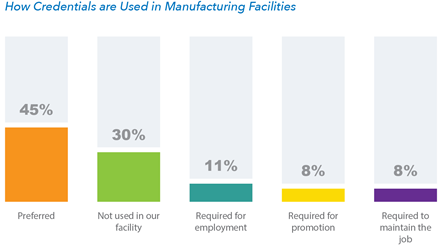Do employers value credentials? How do they use them in their hiring and retention practices? What do employers see as the
right mix of employability and technical skills?
These are among the questions answered by a new Workcred report examining the use of credentials in the U.S. manufacturing sector.
Like many industries, U.S. manufacturing faces a skills mismatch. Job openings exist, but employers cite difficulty finding workers with the right skills.
In our research report funded by the National Institute of Standards and Technology (NIST) Hollings Manufacturing Extension Partnership (MEP), Workcred reveals key
findings about credential use and recommendations on how credentialing can be improved to help U.S. manufacturing keep pace with changing skills needs.
 Our study revealed that credentials have uneven use and are not routinely required or used as a major factor in hiring or promotion decisions. Somewhat surprisingly,
many manufacturers do not know what credentials are available or how they are relevant to their workplace. Many manufacturers also do not view credentials as the most
relevant tools to identify new skilled personnel or to upskill their existing workforce.
Our study revealed that credentials have uneven use and are not routinely required or used as a major factor in hiring or promotion decisions. Somewhat surprisingly,
many manufacturers do not know what credentials are available or how they are relevant to their workplace. Many manufacturers also do not view credentials as the most
relevant tools to identify new skilled personnel or to upskill their existing workforce.
Nevertheless, manufacturers believed that credentials could serve as a critical resource if they were better understood and more in line with needed skills.
To help strengthen the quality, value, and effectiveness of credentials for U.S. manufacturing, the report details recommendations specific to manufacturers, credentialing
organizations, education and training providers, accreditors, and policymakers, addressing themes related to:

Improving understanding about the content, use, and value of credentials

Expanding the use of quality standards for credentials

Strengthening relationships between employers, education and training providers, and credentialing organizations

Adding an employability skills component to existing and new credentials

Creating credentials that focus on performance and address new roles

Increasing the number of apprentices and expanding apprenticeships to more occupations
The report,
Examining the Quality, Market Value, and Effectiveness of Manufacturing Credentials in the United States
, is available as a free download on the Workcred and
MEP websites.
I invite you to check it out and share it with other colleagues interested in workforce credentialing issues. While focused on U.S. manufacturing, the report has important implications
for other sectors as well. After all, increasing the quality of credentials can help improve the effectiveness, efficiency, and performance of the U.S. labor market and the workforce.
Best regards,

Roy A. Swift